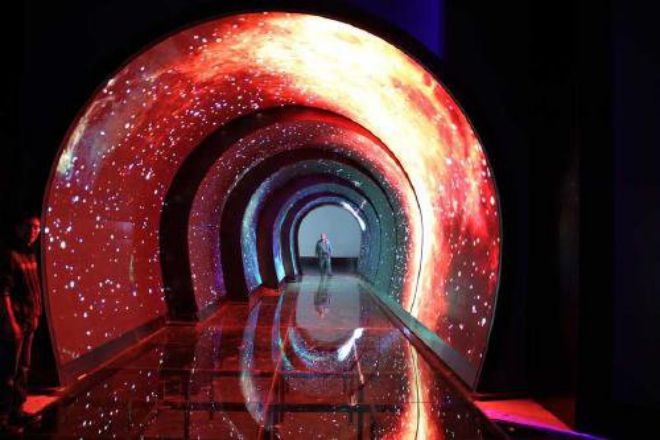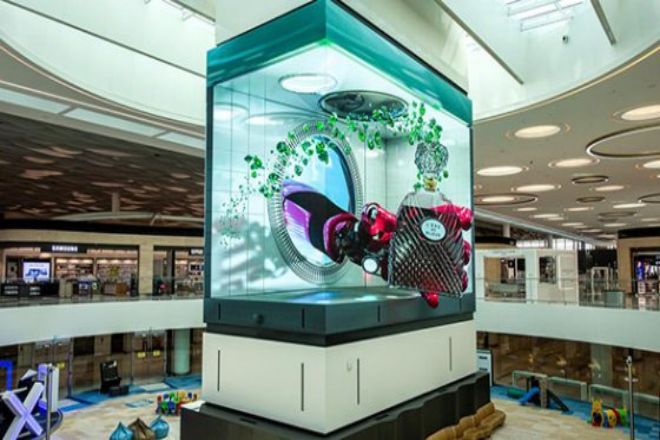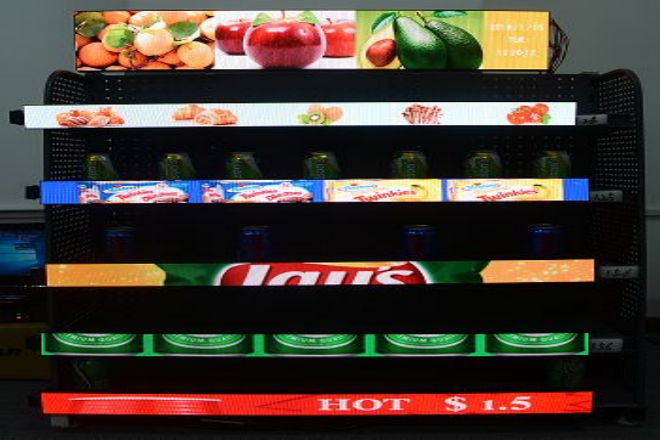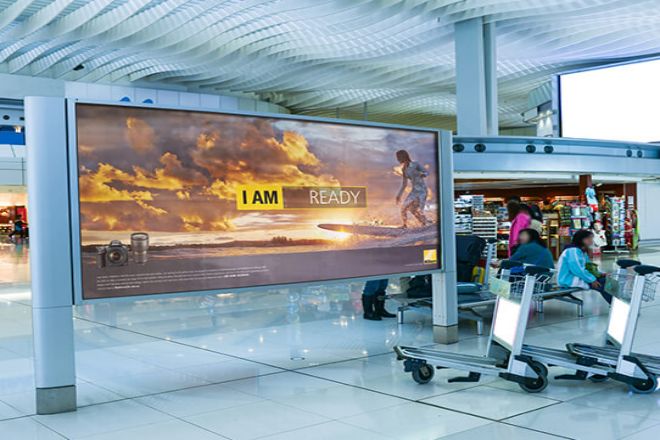مقدمة

In the business world, every moment of attraction and transmission is crucial. شاشة عرض LED, the shining pearl of modern visual art, is quietly changing the pattern of commercial promotion.
It is not only a carrier of information but also a stage for displaying creativity and strategies. Imagine your brand information popping up on the screen in a dynamic and shocking way, instantly grabbing the attention of passers-by and delivering your story directly to your target customers.
This article will unveil the mystery of LED display as a business assistant and directly teach you practical skills that can make you stand out in the market.
From how to choose the display screen that best suits your needs to how to plan eye-catching content to how to use data analysis to optimize display effects, every step will be an accelerator for your business growth.
1. Comparison of promotion advantages: LED display VS traditional promotion media
LED displays do have many significant advantages over traditional media (such as posters, banners, traditional TV screens or projections, etc.).
These advantages make LED displays widely used in modern advertising, information dissemination, entertainment performances, and other fields. Here is a detailed explanation of the advantages you mentioned:
1) عالية سطوع, wide زاوية الرؤية, suitable for outdoor environments:
The LED display screen uses high-brightness LED lamp beads as light-emitting elements to ensure that the picture is clearly visible even in outdoor environments under direct sunlight.
Its wide viewing angle (usually up to 120° to 160°) means that viewers can get good visual effects no matter which direction they look from. It is very suitable for outdoor places with a large flow of people and wide vision, such as squares, commercial streets, stadiums, etc.
2). Bright colors, delicate pictures, and strong visual impact:
The LED display screen can present more vivid and full colors because the LED lamp beads themselves can emit pure color light.
With the advancement of technology, the pixel pitch of LED displays continues to shrink, and the pixel density increases, making the picture more delicate and able to display high-definition or even ultra-high-definition images and videos, bringing a strong visual impact to the audience.
3). Programmable control, flexible and fast content update:
The LED display screen is connected to the computer through the control system, allowing remote control and real-time content updating.
This means that users can change the playback content at any time as needed, whether it is advertising, news, live events, or other multimedia information, and can respond quickly.
The flexibility of programming control is also reflected in the ability to design various dynamic effects, animations, and transition effects to make content presentation more vivid and interesting.
2. 3 key points of LED display promotion content planning

The content planning and creative design of LED display screens are key to ensuring that they effectively convey information, attract the audience’s attention, and enhance the brand image. The following is a detailed elaboration of the three aspects you raised:
1). Content positioning
- Clarify the purpose of communicating information:
Before starting content planning, you must first clarify the main use and purpose of the LED display. Is it for brand promotion, display of product features, release of promotional information, or as a medium for announcements?
Clarifying the purpose will help the subsequent content to be accurately positioned and effectively communicated.
- Develop differentiated content strategies for different time periods and holidays:
Develop different content strategies according to different time periods (such as morning and evening peaks, weekdays and weekends) and holidays (such as Spring Festival, National Day, Christmas, etc.).
For example, during holidays, holiday-themed content can be launched to increase the festive atmosphere; during morning and evening peak hours on weekdays, practical information such as traffic tips or news flashes can be played.
2). Creative design
- Eye-catching visual effects design:
Utilize the high brightness and bright colors of LED displays to design eye-catching visual effects such as dynamic pictures and 3D effects.
Use animation, gradients, flashing, and other techniques to make the content more lively and interesting and increase the audience’s attention.
3). Incorporate brand elements:
Integrate brand elements into creative design, such as brand LOGO, standard colors, brand slogans, etc., to maintain visual consistency and strengthen brand image. By repeatedly displaying brand elements, the audience’s memory, and identification with the brand will be deepened.
- Be concise and clear to avoid information overload:
Taking into account the viewing environment of the LED display and the audience’s attention characteristics, the content design should be concise and clear to avoid information overload. Ensure viewers can quickly capture key information through concise text, clear images, and an intuitive layout.
4). Content update and maintenance
- Establish a content update mechanism:
Establish a regular or irregular content update mechanism to ensure the timeliness and freshness of information. Based on content positioning and strategy, formulate a content update plan and assign dedicated personnel to implement it.
At the same time, remote control technology is used to achieve rapid content updating and switching.
- Periodically check the display status:
Regularly check the hardware and software status of the LED display to ensure stable operation. The inspection content includes but is not limited to display brightness, color uniformity, playback effect, control system stability, etc.
If problems are discovered, repair or replace damaged parts in a timely manner to ensure the normal operation and display effect of the display.
3. How to use LED display to improve customer experience
Using LED displays to improve business efficiency and customer experience is an increasingly common practice in modern retail, service industries, and various public places. The following is a detailed elaboration on the three aspects you raised:
1). Real-time information display
- Display inventory status, queuing progress, etc., to improve operational efficiency:
In retail stores or service centers, LED displays can display product inventory in real-time, helping employees quickly understand which products need to be replenished, thereby avoiding shortages or backlogs and improving operational efficiency.
At the same time, for services that require queuing (such as banks, restaurants, hospitals, etc.), the display screen can update the queuing progress in real-time, reducing customers’ anxiety while waiting and improving customer satisfaction.
- Play weather forecasts and traffic information to provide convenience to customers:
في الأماكن العامة مثل مراكز التسوق, المطارات، and train stations, LED displays can play weather forecasts and traffic information to help customers plan their itineraries in advance and avoid travel affected by poor weather or traffic conditions.
This kind of thoughtful service can enhance customers’ trust and loyalty and enhance the overall customer experience.
2). Enhanced interactive experience
- Combined with touch screen technology to achieve a customer interactive experience:
Combining LED displays with touchscreen technology can create a richer interactive experience. Customers can browse product information, participate in games or sweepstakes, and even place orders directly through the touch screen.
This interactive method not only increases the fun of shopping but also increases customer participation and purchase intention.
- Use QR codes to guide customers to participate in online activities and promote online and offline integration:
Displaying QR codes on LED displays to guide customers to scan and follow brand public accounts or participate in online activities is an effective means to achieve online and offline integration.
Through online activities, brands can further understand customer needs, provide personalized services and offers, and increase customer stickiness and loyalty.
3). Data analysis and optimization
- Collect customer feedback and behavioral data to analyze advertising effectiveness:
LED displays can be equipped with intelligent analysis systems to collect customer behavior data such as viewing time, click-through rate, and conversion rate, as well as customer feedback through questionnaires and other methods.
This data can help brands understand advertising effectiveness, customer preferences, and market demand and provide strong support for subsequent marketing strategy adjustments.
- Adjust content strategy based on data to achieve precision marketing:
Based on the results of data analysis, brands can adjust the content strategy of LED displays to achieve precision marketing.
For example, push personalized product recommendations or discount information based on customers’ purchasing history and browsing behavior; adjust advertising content and style to attract more customers based on external factors such as weather and holidays.
This precision marketing method can improve the conversion rate of advertising and the customer’s purchasing experience.
4. Analysis of classic cases of LED display promotion boost
The following are several examples of LED displays that are not specific to a certain brand to improve business:

1). Information release system for large shopping malls
كبير مراكز التسوق have installed multiple high-definition LED displays inside and outside to release various information in real-time.
These displays not only display the mall’s promotional activities, new product launches, brand pop-up stores, and other information but also update public information such as weather forecasts and traffic conditions in real-time to provide convenience for customers.
1.1). Critical success factors:
Real-time information: The LED display screen can quickly update information to ensure that customers get the latest and most accurate content.
Improve the shopping experience: Displaying promotional activities and new product information stimulates customers’ shopping desire and improves the shopping experience.
Enhance customer stickiness: Providing services such as weather forecast and traffic information enhances customers’ dependence and stickiness on the mall.

2). Entertainment and navigation systems in airport departure lounges
The international airport has installed a large LED display in the terminal to display flight information, airport navigation, weather forecasts, entertainment programs, and other content.
These displays not only help passengers understand flight status in a timely manner but also provide rich entertainment content to relieve passengers’ anxiety about waiting.
2.1). Critical success factors:
Improve passenger satisfaction: Providing comprehensive flight information and entertainment content improves passenger satisfaction and comfort at the airport.
Enhance the image of the airport: The high-tech LED display shows the modernization and efficiency of the airport, enhancing the overall image of the airport.
Promote business cooperation: The display screen can also be used as an advertising platform to attract brand owners to advertise, bringing additional revenue to the airport.
خاتمة
With the continuous advancement of science and technology and the changing market demand, the application prospects of LED display screens will be broader. It is not only a tool for commercial promotion, but also an important tool to enhance brand image, enhance customer interaction, and optimize operational efficiency.
Through studying this article, we hope that you can deeply understand the potential and value of LED displays, and continue to explore and innovate in practice to make it a powerful driver for your business development.
وأخيرًا، إذا كنت تريد معرفة المزيد من المعلومات حول شاشات LED، يرجى الحصول على اتصال معنا.
